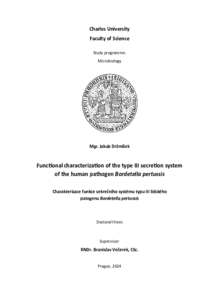Functional characterization of the type III secretion system of the human pathogen Bordetella pertussis
Charakterizace funkce sekrečního systému typu III lidského patogenu Bordetella pertussis
dissertation thesis (DEFENDED)

View/
Permanent link
http://hdl.handle.net/20.500.11956/197519Identifiers
Study Information System: 171409
Collections
- Kvalifikační práce [20809]
Author
Advisor
Referee
Viktorová, Jitka
Kamanová, Jana
Faculty / Institute
Faculty of Science
Discipline
Microbiology
Department
Department of Genetics and Microbiology
Date of defense
21. 1. 2025
Publisher
Univerzita Karlova, Přírodovědecká fakultaLanguage
English
Grade
Pass
Sekreční systém typu tři (T3SS) byl u B. pertussis původně považován za neaktivní, ale později byla popsána jeho aktivita u klinických izolátů a následně také u často pasážovaného referenčního kmene Tohama I po kontaktu s hostitelem a při limitaci živinami. V naší studii jsme prokázali, že nejen nedávno izolované klinické izoláty, ale také málo pasážované historické kmeny produkují funkční T3SS. Pomocí lidské monocytární buněčné linie THP-1 jsme dále ukázali, že exprese T3SS je ve vnitrobuněčném prostředí snížena přechodem B. pertussis do avirulentní fáze. Dále jsme prokázali, že kontakt se složkami krve, ke kterému může dojít na povrchu poškozeného dýchacího epitelu, představuje důležitý podnět pro B. pertussis a také je důležitým předpokladem pro funkčnost T3SS. Mezi proteiny, jejichž produkce byla ovlivněna přítomností krve, jsme identifikovali protein BP2265. Tento chaperon je homologem chaperonu CesT z E. coli, jenž propojuje sekreci komponent T3SS s dalšími buněčnými procesy. Potvrdili jsme, že podobně jako CesT, který patří do třídy chaperonů IA, má protein BP2265 vliv na regulaci metabolismu, virulence a tvorbu biofilmu. Dále jsme prokázali, že protein BP2265 specificky váže anti-sigma faktor BtrA a že je důležitý pro jeho funkční sekreci. Jelikož jsme také pomocí in silico strukturní...
The type three secretion system (T3SS) was originally considered to be inactive in B. pertussis, but it was later described to be active in recent clinical isolates. Later, T3SS activity was observed also in highly passaged reference strain Tohama I upon contact with the host or under nutrient limiting conditions. In our study, we showed that not only recent clinical isolates but also a low-passage historic strain of B. pertussis are T3SS proficient. Using the THP-1 human monocytic cell line, we further showed that the expression of T3SS is reduced in the intracellular environment due to transition of B. pertussis cells to avirulent phase. On the contrary, we demonstrated that the contact with blood components, which may be for example available on the surface of the damaged respiratory epithelium, represents an important cue for B. pertussis and is also an important prerequisite for T3SS functionality. Additionally, our analysis of blood-responsive regulon revealed the novel T3SS chaperone BP2265, a homologue of CesT chaperone in E. coli, which connects the T3SS secretion with other cellular functions. Similarly to CesT, belonging to class IA chaperones, we confirmed that BP2265 is involved in regulation of metabolism, virulence and biofilm formation. Furthermore, we demonstrated that BP2265...
